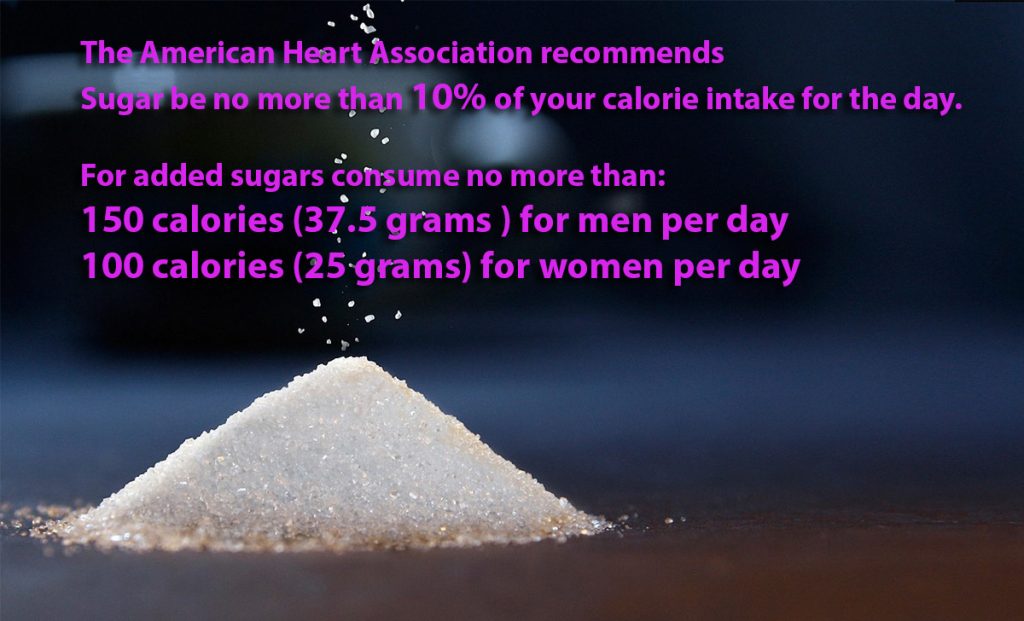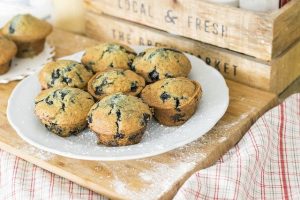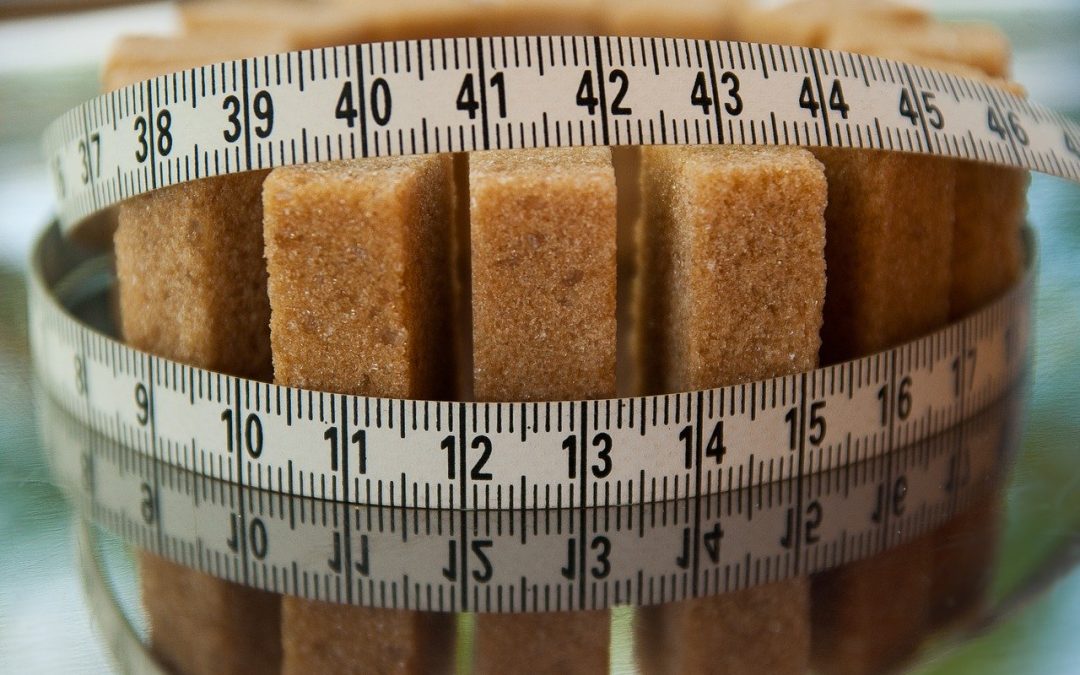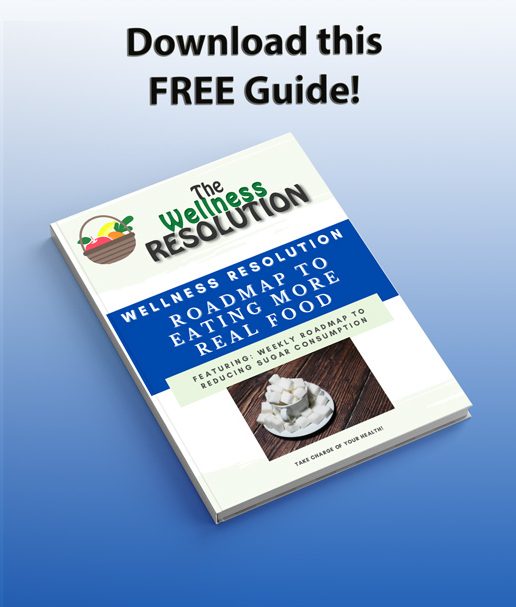If you read my previous blog on how sugar is one of our biggest enemies, you know sugar can be very toxic. You also know our country consumes WAY more than the recommended amounts of sugar. Now, I will share recommendations on how much sugar you should consume. I will also provide some of my personal guidelines for sugar reduction.
View my: Slideshare PowerPoint on Sugar.
How much Sugar Can We Consume Daily?
Some nutrition advice doesn’t provide any formal rules and just tells you general ideas on how to cut back on your sugar intake. But how do you know what foods contain too much? That’s why I follow this baseline below. LESS is BETTER! Don’t try to meet this recommendation, just try to stay below it.
 This would be any type of added sugar including natural ones like honey and syrup but doesn’t include fruit. Note: I use this as a guideline for determining my purchases, but don’t actually count the number of grams of sugar I eat each day. My goal is always to consume less than than the recommended, but at least to stay under 25 grams. However, I might go over when eating out, it is hard to say. But I think that’s okay once in a while.
This would be any type of added sugar including natural ones like honey and syrup but doesn’t include fruit. Note: I use this as a guideline for determining my purchases, but don’t actually count the number of grams of sugar I eat each day. My goal is always to consume less than than the recommended, but at least to stay under 25 grams. However, I might go over when eating out, it is hard to say. But I think that’s okay once in a while.
How About Kids?
It is so important to watch what kids eat! Kids are marketed some of the most unhealthy foods out there. Many problems people see with their kids could be due to sugar such as behavioral problems, heightened energy, sleep issues, and so on…(but there could be other factors too). Too much sugar also sets kids up for an unhealthy future, as well. Kids 2-18 should have no more than 25grams a day, and kids younger than 2 shouldn’t have any sugar.
I have found the best way to meet these guidelines is to look at the packaging of everything you buy, and always pick the brands with the least amount of sugar. Sometimes these will be brands labeled as natural or organic, view my blog on the difference.
Eating a lot of prepackaged food isn’t great though, so you might want to consider replacements for some food items, as well. Can you make that food item from scratch? Don’t feel bad if you have been consuming way too much sugar, the sugar industry tricked us for over 50 years. They made us believe that sugar wasn’t that bad, and fat is to blame for obesity, heart disease, and more. If you haven’t read my blog on this history view the bitter truth here.
Here is a picture of how easy it is to over-consume sugar:
Just in one can of soda such as Coca-Cola there is 39 grams of sugar, and its high fructose corn syrup. Even worse one 20 oz bottle of Mountain Dew is 77 grams of sugar!
Since that is already more than anyone’s sugar intake for the day, I personally do not drink soda under any circumstances.
If you are a regular soda drinker, just cut back slowly over a month or so. You don’t have to quit cold turkey – but eventually, the cravings for sugar will disappear if you just eliminate it completely. I do know how hard it can be because I was once addicted to sugar like many Americans.
Another example is one Milky Way bar 2.05 ounces is 35 grams of sugar – over a woman’s sugar intake for a day and is most of a man’s sugar intake.
It is easy to associate desserts as being your sugar intake for the day, but there are so many hidden sugars in regular everyday food items. There is sugar hiding in bread, all types of condiments, extra sugars in honey and syrup (which are already naturally sweet – totally unnecessary), cereals, crackers, pre-packaged meals, fruit juices, milk, and so on… Your intake of sugar can quickly add up!
Make sure the Honey and Syrup you buy have no added sugar or extra processing! Pay attention to your serving size (1 TBSP of syrup is plenty) you are still consuming sugar even though it actually has some health benefits.
So Where Do You Start?
Steps to Reduce Your Sugar Intake
You can just read labels on everything you buy from now on, or here is a step-by-step guide to ease you into slowly making changes. These are my personal recommendations for how to reduce your sugar in your diet to meet the guidelines listed above.
Step 1: Eliminate High Fructose Corn Syrup

Yes, America’s favorite boxed cookie has this ingredient too! But, I have found 2 replacement brands that taste just as good!
A good place to start is by eliminating or finding replacements for all items that contain high fructose corn syrup. It can hide in bread, various condiments (such as ketchup), honey, syrup, frozen meals, peanut butter, yogurt, protein/nutrition bars. It’s in soda, some ice cream, cookies, juice, jelly, cereal, energy drinks, candy bars, prepackaged cakes, crackers, and more.
If you can afford to, just throw out anything that contains it, it is better for your long-term health and will save you money in the long term. Otherwise, you can make a list of the items you definitely want to replace rather than just not purchase again. Have the list saved in your phone or written somewhere you can access it on your next few grocery trips.
a. Go through your pantry and look at all the labels: check your canned vegetables, soups, cereals, snack foods, etc.
b. Check your refrigerated food.
c. Check your freezer food.
Note: It is okay if this takes you a month or a few months to work on this, you have to start somewhere. Don’t let the stress of it keeping you from making changes. It actually took me a couple of years to cut this out of my diet completely because I had no idea it was in so many foods! I wasn’t reading the labels of everything I bought. You can do this much faster though. You just have to read EVERY label. It hides in foods you wouldn’t even think have added sugar!
Step 2: Choose Foods with Less Sugar (this could be combined with step 1 though)
You are now ready to pay attention to the number of grams of sugar in the foods you buy. Here is where it gets tricky, there are no real rules. My personal recommendations are if anything is over 15- 20 grams of sugar per serving you probably should leave it where you found it. It’s junk. Specifically for condiments and foods that I won’t be eating as a snack/dessert treat, I prefer the label to have no more than 0-5 grams of sugar per serving. Often for condiments, my aim is 0 grams of sugar, but that can be hard to do. Then, for my desserts or snacks, I aim for no more than 10 – 12 grams of sugar per serving. Less is better!
If I were to purchase something like ice cream that has 20 grams of sugar, I will only have half the serving size. But I don’t have these treats often. I like to enjoy food, so I will worry less about it when eating out. In addition, a good rule to follow is to choose food items with the least amount of ingredients. Typically, foods with fewer ingredients are better for you, except when the ingredients are just sugar.
a. You could break this down to first figuring out what sweat treats (desserts) your family consumes and how much sugar they contain, and find replacements. If you are a big dessert family that is a good first step.
b. Pay attention to snacks and frozen meal items.
c. Go through condiments and canned goods and try to find replacements.
Don’t forget about alcoholic beverages!
 If you are a fan of drinks like Mike’s Hard Lemonade (32gram of sugar), Angry Orchard Cider (23grams of sugar), those are drinks you would want to eliminate from your diet to get your sugar levels down. Also, many cocktails can contain added sugars such as grenadine. Alcohol that is very sweet such as Melon liquor, Amaretto, and some Chocolate Liquors can be sugar overload. Premixes of daiquiris, margaritas, etc. often contain artificial sugars and can give you a sugar rush. If you want a sweeter alcoholic beverage try something that uses fruits for sweetness vs. sugar.
If you are a fan of drinks like Mike’s Hard Lemonade (32gram of sugar), Angry Orchard Cider (23grams of sugar), those are drinks you would want to eliminate from your diet to get your sugar levels down. Also, many cocktails can contain added sugars such as grenadine. Alcohol that is very sweet such as Melon liquor, Amaretto, and some Chocolate Liquors can be sugar overload. Premixes of daiquiris, margaritas, etc. often contain artificial sugars and can give you a sugar rush. If you want a sweeter alcoholic beverage try something that uses fruits for sweetness vs. sugar.
NOTE: Over time your sweet tooth does change, you will find certain things are too sweet that you used to think tasted just right.
Guidance on Reading Labels: Added Sugar vs. Natural Sugar
As for reading the labels, if it specifically says “cane sugar” or lists another form of sugar in the ingredients list, there is added sugar. If it says 5grams of sugar is in the nutritional facts, but no sugar is listed in the ingredients list – then it is usually natural sugar. Careful though, as mentioned in my previous blog on how sugar is our biggest enemy, there are many different names for sugar (corn syrup or high fructose corn syrup being the most common). Some labels will say for example 5 grams of sugar, 2 grams of added sugar (so you know 3 grams is natural sugar).
I actually learned a lot from cutting out sugar from my diet completely. If you think this is expensive, trust me it can be a lot worse! Make sure you look at everything prepackaged, it is surprising how many foods have added sugars. Natural sugar is still sugar, but if you are consuming more natural sugar it will be better for you.
Step 3: Limit Treats
Try limiting yourself to just 1 or 2 Sugar treats a day.
This could be a sugary beverage and/or a dessert. I choose to eat only sweet things I really enjoy vs. just like. My favorite treats are some dark organic chocolate that has a bit of added sugar, and a couple of times a week I might have a latte with half the serving size of syrup or just honey.
Also, consider snacks with no sugar or natural sugars. This could be eating some lightly salted nuts, fruits, vegetables dipped in nut butter, sweet potato chips, cassava flour chips with guacamole, or a smoothie made with fresh fruits mixed with some flax seeds or chia seeds. View my snack ideas here.
Also, listen to your body. I can now clearly tell now when I’ve had too much sugar; I often feel lethargic, get a headache, or just feel a bit off in general.
Step 4: Baking
 Some health experts might tell you to use natural sweeteners and not to use refined sugar at all. If you bake a lot, this is definitely something you need to look into. Otherwise, maybe look at recipes that use very little sugar or none at all. This one has been a challenge for me because I have a lot of recipes I love that I couldn’t easily replace sugars for.
Some health experts might tell you to use natural sweeteners and not to use refined sugar at all. If you bake a lot, this is definitely something you need to look into. Otherwise, maybe look at recipes that use very little sugar or none at all. This one has been a challenge for me because I have a lot of recipes I love that I couldn’t easily replace sugars for.
You can easily find recipes without refined sugar online or on Pinterest. Searching for “paleo recipes” is the best way to find them. Some sweetener options to replace refined sugar include honey or syrup (without added sugars), coconut sugar, monkey fruit, or dates. Also, switch from milk chocolate chips to dark chocolate chips preferably 80% dark or higher. FYI: chocolate that says 100% cacao is real chocolate, cocoa is artificial chocolate. If it is organic it should be real chocolate.
Coconut sugar doesn’t always work as a substitute for sugar. It is better in recipes with lots of flavors vs a recipe with minimal ingredients because you will really notice the nutty flavor in a smaller recipe. Bob’s Red Mill Organic Coconut Sugar, 13 Oz
Artisan Kettle Organic No Sugar Added Dark Chocolate Chips These chocolate chips are SUGAR-FREE using stevia as a healthy, natural sweetener. A great way to get your sugar levels down. They taste pretty good for sugar-free chocolate and work especially great in recipes. View Item
Watch out for food labels saying “SUGAR-FREE”
This label often means added chemical toxins that often stay in your body long-term and do more damage than just plain sugar ever will! Chemical sweeteners can upset your stomach, cause headaches, spike your blood sugar, and possibly cause diabetes. They can also increase your appetite for sugary foods. View more on the dangers of Harvard Health – Artificial sweeteners: sugar-free, but at what cost? and Dr. Axe – The 5 Worst Artificial Sweeteners, Plus Healthy Alternatives. So check the labels on everything you buy! Make sure to check the labels for foods that may seem healthy like granola bars and even organic food!
Bakerita: 100+ No-Fuss Gluten-Free, Dairy-Free, and Refined Sugar-Free Recipes for the Modern Baker REFINED SUGAR-FREE! This cookbook could be just what you need to get started with not only healthier, delicious recipes, but information on the different ingredients that are gluten-free, dairy-free, or refined-sugar-free.
A recipe book with over 100 recipes and fun and funny step-by-step photographs and cartoons. Makes cooking fun! No added sugars and unprocessed ingredients. Nom Nom Paleo: Food for Humans
COST SAVINGS!
Chronic Illness costs roughly $5,300 per year (according to the CDC). If you spend $50 extra in groceries a week that is $2,400 a year, so you are coming out ahead. That is not even accounting for the emotional and physical costs of being chronically sick. I would love to be able to just spend money on preventative health and not fixing my health.
Reducing Sugar Cravings & Improve Side Effects
If you are in fact addicted to sugar (don’t worry you are not alone, most of us are or have been) you might notice some side effects. Some studies have shown sugar to be addictive as nicotine or cocaine to the brain. Eating something sweet feels rewarding.
Side effects may include lots of cravings, you might feel a bit fatigued, have concentration issues, anxious feelings, mood changes, or trouble sleeping. Symptoms will disappear quickly if you just cut out processed sugar almost completely. However, to deal with symptoms it will be helpful to drink a ton of water, eat healthy proteins and vegetables, avoid processed carbohydrates (that means flour). Also, keep your stress under control because high stress may increase sugar cravings. Then, just get plenty of exercise and sleep. Finally, make sure to eat some fruit to help with those cravings for something sweet.
It includes recipes, shopping lists, meal prep guides, everything you need to make real changes, and not miss that sugar rush. Sugar Detox in 10 Days: 100+ Recipes to Help Eliminate Sugar Cravings
Ready to Make Some Changes?
When you have digested this information, check out my blog on foods that convert to sugars in the body. Are you thinking: bread, pasta, items with white flour? Yup, that’s right. Those things and more!
Download this Free Guide:
Roadmap to Eating More Real Food & Reducing Sugar Consumption
View More Healthy Eating Blogs
- 8 Tips on How to Eat Less Packaged Food (Less Junk Food)
- Over 30+ Gluten and Dairy Free Breakfast Ideas (& Sugar-Free)
- Reading and Decoding Food Labels & Toxic Ingredients
- 11 Superfoods for a Diet Higher in Nutrients
- 30 Clean Snacks and Desserts (Gluten-Free, Sugar-Free & Dairy-Free Options)
- How to Choose Healthier Dairy Products & Alternatives to Dairy
- The Truth About Milk – Why We Don’t Need it to Stay Healthy
- Wild Caught vs Farm Raised Fish – What is the Difference? Which is Healthier?
- How to Choose Healthier Meats
- What Does Non-GMO Mean? Are GMOs Safe?
- How to Eat Real Foods & Why It Is Essential for Your Health
- When is Organic Really Worth it?
- Organic vs. Natural: What is the difference?
- Is White Flour Bad For You? Should We Be Eating Less Carbs?
- How the Sugar Industry Tricked us for 50 Years
- Sugar Pains? Sugar – One of our Biggest Enemies!
I have a Wellness Coach Certificate, I'm an entrepreneur, an innovator, writer, and artist. My expertise includes over 7 years of marketing, research, and developing content for holistic health businesses. Plus, my own personal journey of becoming chronically sick: understanding what went wrong, and finding a way to heal and live a healthier life. I have a passion for wellness with a wealth of knowledge surrounding: wellness, flaws in healthcare, root causes for chronic illnesses, and alternative treatments.



